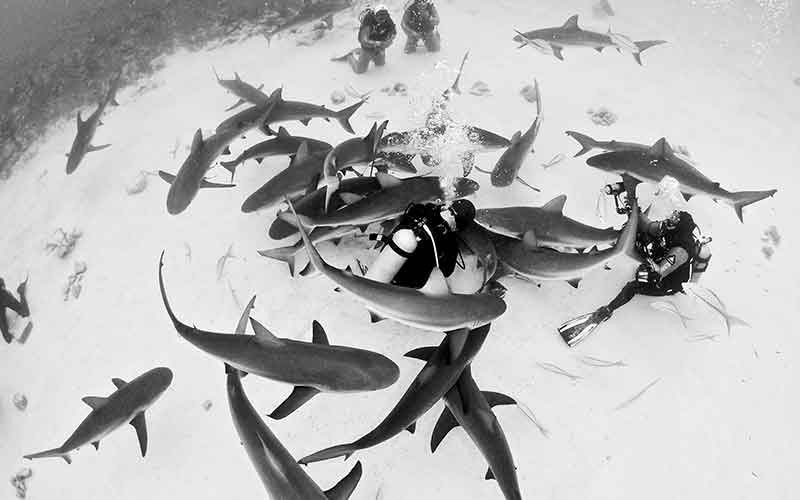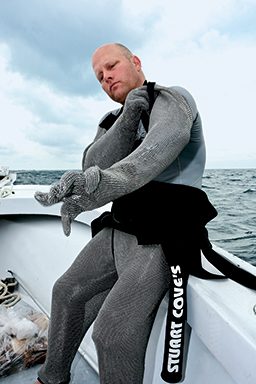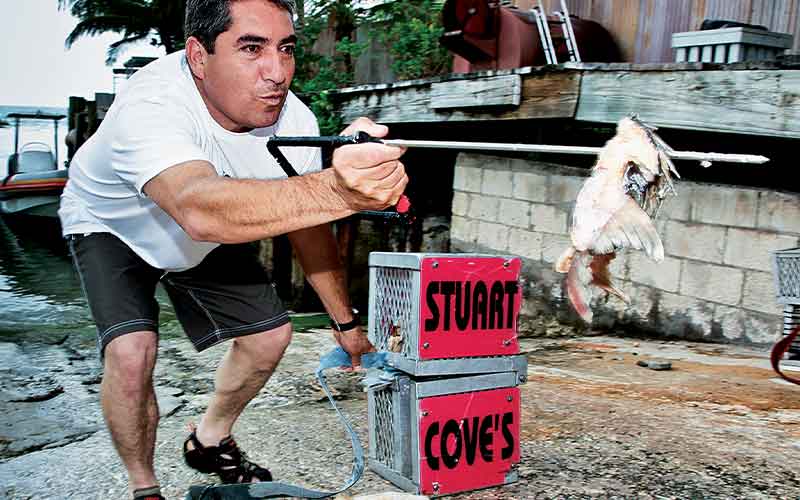I eye a 6-foot Caribbean reef shark as it glides over the sands of Shark Arena, 45 feet below the surface off New Providence Island, the Bahamas. The shark is one of 20-plus hungry, attentive reef sharks that swarm around me. I skewer a grouper tail with a slender stainless-steel rod and lift the bait precariously out of a bomb-proof bait box that rests at my knees. I offer up the treat as one might a bone to a bounding Great Dane. My gaze locks eyes with the approaching predator, my signal to the shark that I have chosen it to receive my gift. “Come and get it,” I say in my mind. Suddenly, from outside my peripheral vision, three other sharks have a different plan and charge through my legs and over my shoulder toward the bait.
I struggle to keep my balance as I am bumped and pushed by the sharks vying for the prize. In the torrent of churned bubbles, sand and sharkskin, I lose sight of the bait box, my instructor, the photographer and my dive buddy while the bait slides from the tip of the skewer toward my fingers. Suddenly I am aware my hand is in the mouth of one of the frenzied sharks, and I feel pressure build as it bites down on the bait … and me. Contrary to my training, I instinctively pull my hand back and immediately feel rows of sharp teeth catch on the chainmail that protects me. For the first time during Stuart Cove’s Shark Feeder and Awareness Program, I begin to panic. Words from my instructor, Rupert Raven, push through the adrenaline: “Pull your elbow in, then get the shark in a kind of headlock and pry its mouth open with your free hand. Don’t try to pull your hand out aggressively or you may risk injury.”
I pull in my elbow, straining to do so calmly, yet before I am able to make the next move, the shark opens its mouth and sets me free. The food has been stolen by another, and a mouthful of chainmail is thankfully unappetizing. I examine my hand — five fingers, no blood, seems to work. Calm returns. I pick up the skewer off the sand, dig into the bait box for a new tail and seek another oncoming shark to feed.

Ever since I spent a week diving Darwin’s Arch in the Galapagos, I have been keenly interested in pelagic conservation, sharks in particular. When I learned of the excellent shark sightings in the Bahamas from underwater photographer Andy Sallmon, I did a little research and discovered Stuart Cove’s Dive Bahamas offered not only regular shark interaction dives for novice divers, but more advanced shark certification programs as well.
“The whole program was actually born out of boredom,” explained founder Stuart Cove. “Years ago, I was fishing with some buddies, and sharks would routinely circle in hopes of a scrap or an easy meal. One day, one of my buddies challenged us to jump in with the sharks. ‘Are you crazy?!’ was my first thought, but we brought along our gear next time, and in we went. None of the sharks bothered us, and what we saw was simply amazing. It changed all of our perceptions of sharks, and I knew immediately others would love to see this. We’ve been introducing people to these graceful creatures ever since.”
I arrived in the Bahamas to take Stuart Cove’s Shark Feeder and Awareness Program; it began with a classroom specialty course, a blend of video, discussion and scientific text that provided an excellent foundation of shark knowledge, including how to distinguish the various species, as well as the plight most of them face.

When our classroom session ended, a shark-feeding clinic began. My buddy, Martin Vega, and I headed outside and were introduced to the bait boxes: thick, welded contraptions built to take a beating. We learned how to secure a piece of bait with a narrow stainless rod and protectively draw it out while blocking views and access; this is important to prevent sharks from nosing in, tipping the box and triggering a feeding frenzy. We were taught the “polite” feeding method, or how to pick a single shark using eye contact, and move the piece of bait at a safe distance in a smooth arc in front of us, allowing the shark to take the bait easily as it coasts by.
Last, we were fitted for a Neptunic stainless-steel chainmail suit and protective helmet. The helmet is the equivalent of a hockey helmet, but the chainmail suit is unlike anything I have worn before. Comprised of leggings, sleeves and gloves, it is weighty, cumbersome and mildly awkward — but it’s very protective.
There’s reading, there’s watching, and then there’s doing. It’s a powerful distinction; with engagement comes relationship, kinship and respect. These outcomes are one of the big motivators that inspire Stuart Cove’s shark programs — once people see sharks on their terms, on their turf, they no longer think of them as mindless killers, but as graceful members of the circle of life.
Finally, it was time for the “doing” — our first shark dives. We boarded the boat with divers from around the world and motored the short distance for a check-out dive at Shark Wall, a reef and wall dive starting at 50 feet. No feeding or close shark interactions were planned, just a comfortable reef dive where we were likely to see sharks at a distance, thereby determining the comfort level of the group. We explored the hard and soft corals that form the reef and saw angelfish, groupers, parrotfish and the invasive lionfish, but no sharks … at first. As we began our return to the boat, we saw the unmistakable outline of Caribbean reef sharks above us. First one, then two, and then five. I was certain the arrival of divers at this hour, repeated for years, has formed a habit for the neighboring sharks as powerful as a dinner bell. Supper was soon to be served.

Vega and I suited up in our chainmail and helmets for our second dive. We were the only guests who did so. Everyone else was to observe, but as students of the shark feeder program, Vega and I were given the chance to step into the ring and actually feed. The group returned to the water. Sharks were now definitively present, and we descended past more than a dozen on the way to the sand where we knelt in a circle facing inward, our hands crossed tightly in front of us — flailing limbs are forbidden as they may be mistaken for food.
Then Rupert Raven, the pied piper of Shark Arena, descended with his bait box dangling below him. More sharks followed casually behind him. He knelt in the center of the circle and displayed textbook skills as he calmly opened the box, procured a piece of bait, eyed a shark and offered up the frozen tail for a snack. Soon more than 20 reef sharks, averaging 5 to 8 feet in length, swarmed above the group. One after another, Raven drew them in and fed them. I felt about as threatening, or as threatened, as a rock. Sharks swooped over our heads, often within inches, past our shoulders, next to us and between us as though we weren’t there. At that moment, the universe for these sharks included only two things: Raven and a box full of grouper tails.
After 15 minutes, Raven motioned for me to take his spot in the center of the ring. Once in place, the sharks must have recognized an amateur in their midst, for the crowd closed in and began to charge the bait box with greater frequency. I fumbled with the lid, trying not to let a shark get its nose in as I lifted it, but as soon as it cracked open, I was bumped by three or four sharks. I clamped it back down and waited for the swarm to clear. I tried again and got one piece of bait on the rod, lifted it out of the box, eyed a shark and watched the piece promptly slide off into the sand.
The rush for the grouper tail was like a frenzied pack of puppies, twisting and turning and trampling each other in the hope of snagging the dropped treat. I repeatedly found myself straddling different 7-foot sharks as they nosed their way between my thighs to get at the box. Others knocked the box in the hope of spilling the contents, while others circled to catch my eye for a tasty treat. As the excitement died down and the crowd dissipated, I lifted the lid on the box and skewered another tail. I eyed another shark coming in from my left and held it out for him. He swooped in, took the bait easily in his mouth and continued on past, all at a safe distance from me and the nearby photographer.
Sadly, too much of the public has shaped their impressions of sharks from Jaws and other sensationalist portrayals of these extraordinary animals. As vital members of the undersea ecosystem, sharks are being fished (slaughtered) at an unsustainable rate. I am not going to posit an opinion on the positive or negative effects of regular “polite” feeding of sharks and how it may or may not impact their natural habits, hunting skills or health. But it’s possible that safe first-hand interaction or observance of these stunning creatures may have the most profound impact on their survival by shifting humanity’s impression of them.
Sharks’ greatest nemeses are humans, and if more people have an opportunity to see sharks in the open ocean, to witness how they move, interact and feed, they might discover how magnificent sharks are and how little risk they pose to humans. Then maybe, just maybe, those same people will be vocal enough to push for sustainable harvesting practices around the globe — or perhaps end the consumption of sharks altogether.
One thing is certain: The conservation of sharks in and around Nassau is very good for local dive-related businesses, and it’s those businesses that work for and have a significant effect on the conservation of local shark populations.
© Alert Diver — Q4 Fall 2010